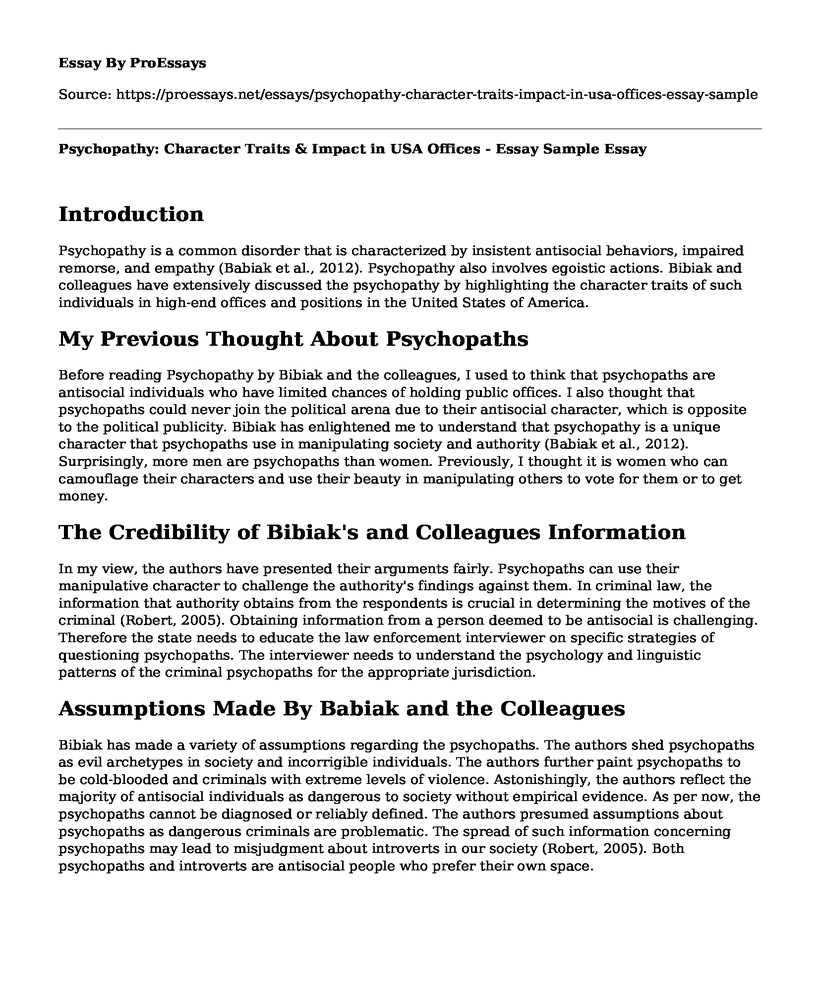Introduction
Psychopathy is a common disorder that is characterized by insistent antisocial behaviors, impaired remorse, and empathy (Babiak et al., 2012). Psychopathy also involves egoistic actions. Bibiak and colleagues have extensively discussed the psychopathy by highlighting the character traits of such individuals in high-end offices and positions in the United States of America.
My Previous Thought About Psychopaths
Before reading Psychopathy by Bibiak and the colleagues, I used to think that psychopaths are antisocial individuals who have limited chances of holding public offices. I also thought that psychopaths could never join the political arena due to their antisocial character, which is opposite to the political publicity. Bibiak has enlightened me to understand that psychopathy is a unique character that psychopaths use in manipulating society and authority (Babiak et al., 2012). Surprisingly, more men are psychopaths than women. Previously, I thought it is women who can camouflage their characters and use their beauty in manipulating others to vote for them or to get money.
The Credibility of Bibiak's and Colleagues Information
In my view, the authors have presented their arguments fairly. Psychopaths can use their manipulative character to challenge the authority's findings against them. In criminal law, the information that authority obtains from the respondents is crucial in determining the motives of the criminal (Robert, 2005). Obtaining information from a person deemed to be antisocial is challenging. Therefore the state needs to educate the law enforcement interviewer on specific strategies of questioning psychopaths. The interviewer needs to understand the psychology and linguistic patterns of the criminal psychopaths for the appropriate jurisdiction.
Assumptions Made By Babiak and the Colleagues
Bibiak has made a variety of assumptions regarding the psychopaths. The authors shed psychopaths as evil archetypes in society and incorrigible individuals. The authors further paint psychopaths to be cold-blooded and criminals with extreme levels of violence. Astonishingly, the authors reflect the majority of antisocial individuals as dangerous to society without empirical evidence. As per now, the psychopaths cannot be diagnosed or reliably defined. The authors presumed assumptions about psychopaths as dangerous criminals are problematic. The spread of such information concerning psychopaths may lead to misjudgment about introverts in our society (Robert, 2005). Both psychopaths and introverts are antisocial people who prefer their own space.
The Usefulness of Babiak's and Colleagues' Information
Babiak and the colleagues present credible and reliable data concerning criminal psychopaths. Employees can use the information in a different organization set up to identify psychopaths who may pose threats to their lives. The data can also be used by criminal justice professionals and psychologists who can do further studies to understand the psychopaths. The general public should realize that it is challenging to identify the motives of other individuals (Babiak et al., 2012). Although Babiak and the colleagues present antisocial people as dangerous, it should be understood that currently, there is no empirical evidence that declares unfriendly characters as psychopaths. It is also still unclear whether psychopaths are harmful to the society, as Biabiak and colleagues claim.
Reflection on "This American Life"
I second the need to diagnose people with psychopathy. It will ease the ruling of criminal cases against such individuals ensuring justice to all individuals. On the other side, diagnosing people with psychopathy may lead to discrimination. Psychopaths may be discriminated against in job interviews or the community. Other people will also treat psychopaths to be dangerous.
Conclusion
Babiak and colleagues have excellently described the characters of the psychopaths. To some extent, I feel their discussion is harsh to antisocial individuals. Empirical evidence needs to be presented to enable accuracy in the judgment of psychopaths in criminal justice.
References
Babiak, P., Folino, J., Hancock, J., Hare, R. D., Logan, M., Mayer, E. L., & Pinizotto, A. (2012). Psychopathy: A crucial forensic concept for the 21st century. FBI L. Enforcement Bull., 81, 3. Retrieved from https://www.google.com/url?sa=t&source=web&rct=j&url=https://leb.fbi.gov/articles/featured-articles/psychopathy-an-important-forensic-concept-for-the-21st-century&ved=2ahUKEwiMiqzkgp7lAhUND2MBHbbdDv8QFjAAegQIAxAB&usg=AOvVaw0efy0QKYY27BrjvDgjganG
Robert, D. (2005). Actuarial justice. Encyclopedia of prisons & correctional facilities. Thousand Oaks: Sage. Retrieved from https://www.google.com/url?sa=t&source=web&rct=j&url=https://marisluste.files.wordpress.com/2010/11/actuarial-justice.pdf&ved=2ahUKEwjylNeAgZ7lAhUKEBQKHVe8DXUQFjAAegQIARAB&usg=AOvVaw2NoNN7VWeHHJKIIvnxj6er
Cite this page
Psychopathy: Character Traits & Impact in USA Offices - Essay Sample. (2023, Feb 26). Retrieved from https://proessays.net/essays/psychopathy-character-traits-impact-in-usa-offices-essay-sample
If you are the original author of this essay and no longer wish to have it published on the ProEssays website, please click below to request its removal:
- The Problem with Fat Talk by Renee Engeln - Article Analysis Essay
- Effects of Job Stress, Attitude, and External Market on Employees' Turnover
- Family Life Education Programs Addressing Socioemotional Topic Essay
- An Analysis of Depressive Disorder's Articles Paper Example
- Paper Example on Suicide: A Global Tragedy With Individual Implications
- Essay Example on Anthony Quinton's Concept: Personality, Identity, and Memory
- West vs East: Understanding Facial Emotions in Social Contexts Essay







